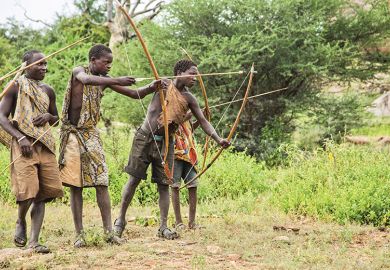The Guayaki once roamed the forests of what is now eastern Paraguay and northeastern Argentina, on both sides of the great Parana river.
After centuries of intermittent warfare with other encroaching tribal peoples, they were gradually confined to a small area of forested land in southeastern Paraguay.
One of the groups with which they came into conflict, the Guarani, regarded the Guayaki as scarcely human, spreading stories about these diminutive hunter-gathers and their bizarre habits so that as one of the least known tribes in South America they became almost legendary.
In 1963, on Alfred Metraux's advice, a young French anthropologist, Pierre Clastres, contacted two groups of Guayaki. They had recently migrated out of the forest to live close to a white settler who had proffered them some protection against marauding Indians and beeru (whites) who allegedly hunted them down on sight like wild animals, capturing and enslaving women and small children and killing the men. Clastres writes of "this enigmatic tribe which had been hiding for centuries" and of how he anticipated "with delicious excitement ... walking into the middle of a tribe of cannibals", for such was their reputation.
When Clastres died tragically in a car accident in 1977 he had already published his account of the Guayaki with Plon. Surprisingly it does not seem to have been reviewed by any of the main anthropological journals.
Paul Auster completed his English translation of the book in 1976 and his introduction recounts the bizarre disappearance of his manuscript and its reappearance 20 years later by the hand of a bibliophile who had rescued it from a remainder bin in a secondhand book-store.
More extraordinary is the story Clastres himself tells about the Ache (or Atchei Gatu) and of the Iroiangi, the so-called "strangers", both nomadic groups of Guayaki Indians with whom he and an unamed colleague (the late Lucien Sebag) lived in 1963.
The Jesuits, who were so successful in their proselytising of Amerindians during their 200-year sojourn in Paraguay and the Gran Chaco before their expulsion in 1767, failed to convert the Guayaki.
It is recorded that with the aid of their Guarani emissaries they would capture Guayaki, but because of their intractable nature they were allowed to return to the forest.
Although some of the Jesuits' Guayaki manuscripts appear to have been lost, Pedro Lozano published a description of their culture in his history of the Jesuits in Paraguay in 1754.
During the late 19th century, more substantial observations were documented by C. de La Hitte and H. Ten Kate, and in the following decades by F. C. Mayntzhusen and J. Vellard.
It was, however, the more recent research of G. T. Bertoni on Guayaki language (which is a dialect of classic Guarani), and particularly that of the Paraguayan Leon Cadogen, who sent Clastres tapes of spoken Guayaki to study during four months' preparation in Paris prior to his fieldwork, which facilitated Clastres' initial rapport and subsequent understanding of the Guayaki during the relatively brief eight months he actually spent with them in the field.
Written in an engagingly reflexive style, Clastres' book is a stunning evocation of a quite extraordinary way of life - an extreme example of the human condition.
His evident compassion for these people and their predicament helps to assuage what might otherwise be too horrific to contemplate. His descriptive passages of various events, some almost too painful and saddening to read, is masterful.
The reasons he gives for their cannibalism however - to protect the souls of the living against those of the dead who will not depart until all have partaken - does raise a still unresolved question: why did close kin abstain?
His story confronts this dire custom and the revenge killing of children with the pathos of innocence on the part of the Atchei Gatu (the Iroiangi were not anthropophagous) who accepted this traditional custom. This is not a book for the faint-hearted.
Three years prior to his own death, Clastres wrote in L'Homme an obituary to his friend Cadogen in which he refers to "l'extermination bestiale des Indiens Guayaki, pendant l'annee 1972" and that "Jusqu'au dernier moment, L. Cadogen a tente d'empecher le genocide".
Thus his book, faithfully translated by Auster, is all that remains, apart from Clastres' articles in academic journals, of this extraordinary, brief and ultimately tragic encounter.
Donald Tayler is lecturer in ethnology and curator, Pitt Rivers Museum, Oxford.
Chronicle of the Guayaki Indians
Author - Pierre Clastres
ISBN - 0 571 1938 6
Publisher - Faber
Price - £9.99
Pages - 240
Register to continue
Why register?
- Registration is free and only takes a moment
- Once registered, you can read 3 articles a month
- Sign up for our newsletter
Subscribe
Or subscribe for unlimited access to:
- Unlimited access to news, views, insights & reviews
- Digital editions
- Digital access to THE’s university and college rankings analysis
Already registered or a current subscriber?



